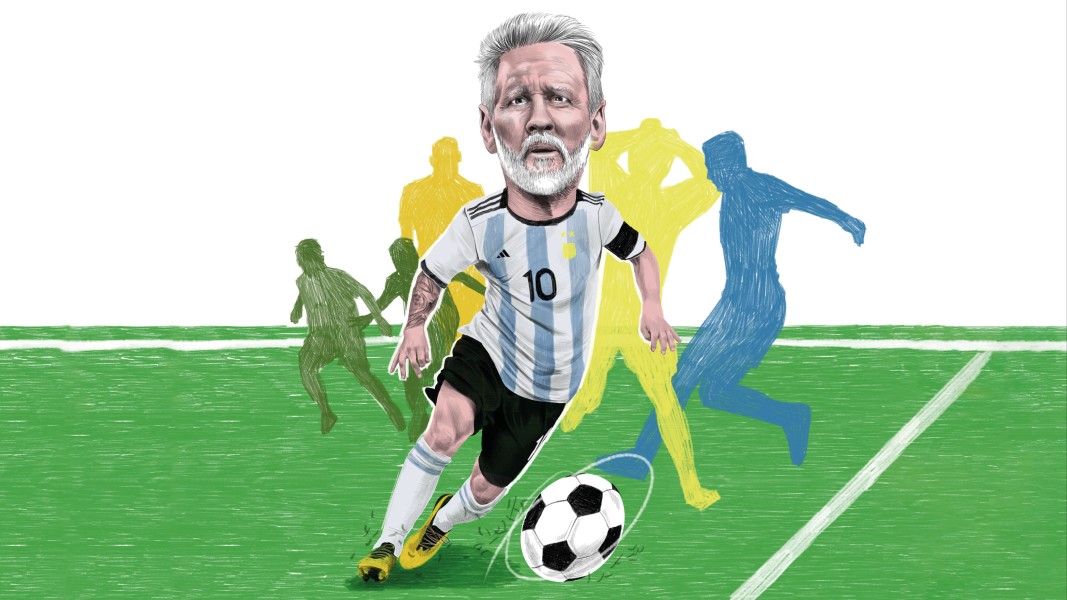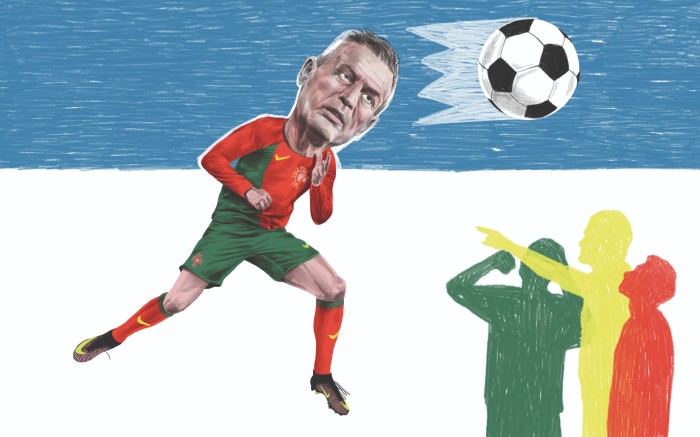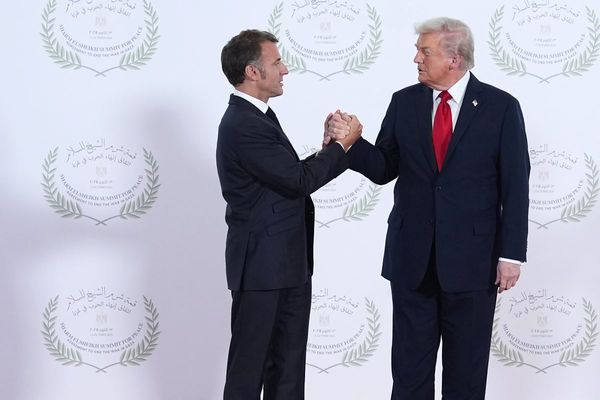
Last year, I lived three metro stops from the Santiago Bernabéu stadium in Madrid, and so I spent many evenings watching Karim Benzema. Real Madrid’s French forward — who last month won the Ballon d’Or for world’s best player, aged 34 — spends much of each game strolling around. He is scanning, clocking the location and directional movement of every player around him, as if that trademark bandage on his damaged right hand concealed a GPS. Then, when he suddenly breaks into a sprint, he is telling his teammates: “I have seen a gap. Give me the ball now.”
Once they feed him, he keeps scanning even while on the ball in the penalty area. He takes every split-second the defenders leave him until he identifies the optimal choice, whether that’s shooting or passing off any part of either leg. When the ball goes in, Benzema generally even celebrates calmly. He had seen the goal coming before anyone else did. In Qatar, he aims to win the World Cup with France. Benzema (who before this year had never finished in the top 15 for the Ballon d’Or) exemplifies a trend of this tournament, and indeed in modern sports: many of the best players are entering middle age.
A crop of men born between 1985 and 1988 are among the biggest names going to this World Cup. Leo Messi, probably still the world’s best footballer, is 35. Cristiano Ronaldo remains Portugal’s most reliable goalscorer at 37, the same age as Croatia’s playmaker Luka Modrić, who recently joked (if it was really a joke) that he might play until 50. Between them, this trio has won every Ballon d’Or since 2007. Those who felt Messi didn’t deserve his seventh award last year were backing Poland’s centre-forward Robert Lewandowski, now 34. No player born after 1987 has won the Ballon d’Or. The world’s best young footballer, Norway’s forward Erling Haaland, 22, isn’t even going to Qatar because his team didn’t qualify.
Relatively geriatric stars rule in other sports too. Serena Williams and Roger Federer dominated tennis until not long before retiring this summer, aged 40 and 41, respectively. Rafael Nadal, 36, and Novak Djokovic, 35, remain top players. Only in 2020 did Dominic Thiem become the first man born in the 1990s to win a Grand Slam. In Formula One, Lewis Hamilton appears to have started his decline only this year, aged 37. Equally old LeBron James remains a great basketball player, while quarterback Tom Brady recently returned to the NFL, aged 45. It’s tempting to see a trend here, to conclude that better diets and medical care, plus stricter rules against dangerous tackles in soccer and the NFL, have prolonged athletic careers.
Certainly today’s footballers take better care of themselves than their predecessors. George Best was an alcoholic; Johan Cruyff, a chain-smoker; and Diego Maradona, a cocaine addict. More recently, Wayne Rooney managed his stress through solitary two-day drinking binges. By contrast, many players going to Qatar are teetotalling vegans with gymnasia in their basements. The older they get, the more they tend to ratchet up the self-care. Arsenal’s former manager Arsène Wenger, explaining Benzema’s improvement in footballing old age, noted: “Until 30, he had two or three kilos too many.” Messi and Ronaldo also lost weight after shifting to radical long-term diets.
For a measure of changing times, check out the selfie taken by Sweden’s 41-year-old striker Zlatan Ibrahimović (whose country also failed to qualify for Qatar) in his underpants, and then leaf through 1970s’ English Panini sticker books. Back then, many players by their late twenties were paunchy, wrinkled and toothless — the effects of humble postwar upbringings and playing careers structured around all-day pub “lunches”.
So the thesis of a general ageing in sport makes logical sense. There’s only one problem: there’s almost no evidence for it. In global football’s dominant league, the English Premier League, there is no long-term data showing that teams or goalscorers are getting older, says the head of data at one leading club.
When The Athletic website last year gauged “peak player age” by analysing which players in the Premier League got the most playing minutes, it concluded: about 27 years old for center backs and strikers, 26 for wingers and 25 for full-backs and central midfielders. True, the average age of players in the Champions League did rise from 1992-93 through to 2017-18, but only modestly, from 24.9 years to 26.5. Meanwhile in American male major league sports, teams are actually getting younger for a variety of reasons. In other words, Benzema et al are outliers.
Why doesn’t improved care seem to have increased overall longevity in football? Well, younger players are also looking after themselves more, and they are at an advantage as the game speeds up. The dominant tactical style now is aggressive pressing: the moment a team loses the ball, players combine to chase up opponents. Wenger told me in 2020: “Today, football goes at 200 miles an hour, so you have to show first that you can go on the train. Once you’re on the train, you can express your talent. But if you cannot get on the train, you don’t play.” High-intensity sprints — usually pulled at the moment one team wins the ball — are increasingly valued in football, and younger players make more of them.
No matter what athletes do to stay fit, they will enter physical decline even before turning 30. The first thing to go is flexibility. Then, from about the late twenties, cardiovascular capacity starts to fall, reducing endurance. Around the same age, athletes begin losing muscle power. A footballer at 30 will jump more slowly and less high than before. Reaction times drop too. Strength goes last since muscle and bone mass only decline in one’s thirties. Meanwhile, injuries picked up over a career take a cumulative toll. The best advice on ageing remains: don’t do it.
So there are two apparently contradictory facts. One: there is no general ageing trend in male sport. Two: many of the best players in various sports are old. What explains this?
To understand what’s going on, it helps to know that this isn’t the first time people have heralded a supposed ageing in sport. In the late 2000s and early 2010s, there was a crop of forty-something footballers: Paolo Maldini and Alessandro Costacurta at Milan and, later, Ryan Giggs and Edwin van der Sar at then dominant Manchester United.
They had peers in other sports. Martina Navratilova won her last mixed doubles title in the US Open aged 49, shortly before Barry Bonds retired from baseball aged 43 in 2007. When I asked how she did it, she talked about her diet (she once drank so much carrot juice that she turned orange) but finally admitted: “I don’t know why I can still play as well as I can. Here I am, older than most players’ mothers. I can still hit a 105-mile-an-hour serve. Gordie Howe [who played a season in the National Hockey League aged 51] is the only athlete I know that’s done it at this age.”

One winter’s day in 2008, hunting for the secret of eternal youth, I visited AC Milan’s training ground at Milanello, in the countryside near Lake Como. It was possibly the world’s nicest office. The air was so clear that, at 10 metres, you could see the pores in a man’s skin. The training fields were so flat that you could lie on the ground and not see a single undulation. I sat in the bar, drinking perfect espressos for free, and every young man who passed, world champion or not, said, “Buongiorno.”
Outside, the oldest squad in the history of top-class football sauntered around the training pitch, all of them still perfect straight-backed athletes. In 2007, Milan had won the Champions League with a starting eleven in which most players were 31 or over.
A tall, grey-haired man in a blue suit and blue trenchcoat gazed down at the squad, puffing a cigarette. This smoker headed football’s leading medical team. Jean Pierre Meersseman, director-general of the so-called Milan Lab, a scientific and medical team that worked for player “wellness”, seemed to have cracked the problem of ageing. When I asked, “What’s the maximum age of a top-class footballer,” he replied, “I think it’s around 40. It used to be 33, 34 at the most.”
He was reluctant to lift the lid on Milan Lab’s secrets, saying little more than: “If you can predict the possibility of injuries, you stop the player before.” By studying a player’s jump, the Lab could predict with 70 per cent accuracy whether he would get injured. Each player was given a rating between one and 10 for his structural, mental and biochemical levels. Anyone rating 4.7 or below was at risk of injury. The system worked. “The extent of non-traumatic injuries has been drastically reduced by well over 90 per cent, compared to the previous five years,” said Meersseman. “So that’s an interesting concept.” In short, care was improving even then.
But there’s something else he said that day that probably does more to explain the endurance of Benzema et al today. Meersseman was eulogising Milan’s Brazilian striker Ronaldo, a brilliant, injury-prone player who enjoyed the good things in life and wasn’t big on self-care. “Ronaldo,” marvelled the doctor, “he can perceive situations so fast, and react too.” The Brazilian seemed to see the game unfold almost in slow motion.
The Milan Lab believed that this quality of “sensory perception”, “interpreting detail inside the brain”, might be the most important in football. And it is a quality that improves with age, both in run-of-the-mill players and in stars. Improved interpretation of detail presumably explains why players increase their passing accuracy by 0.25 per cent with each year that they age.
But improved sensory perception isn’t enough to keep most older footballers going. Their loss of other qualities outweighs this gain. They become old heads on old legs. Only the greatest footballers are worth keeping into middle age. In a game where pressing has shrunk playing space, the sensory perception of a Benzema or a Messi who can find the tiniest gaps is simply too valuable to lose. Younger teammates compensate for things the old man can no longer do. At Paris St-Germain, for instance, Morocco’s right-back Achraf Hakimi serves as Messi’s legs, covering the gaps he leaves, allowing the old man to focus exclusively on high-value activities. Like Benzema, Messi strolls around, scanning the field, registering where everyone is. Old stars reserve their strength for the moments that count, typically around the opponent’s goal. Wenger said, “The best strikers in Europe are all over 30 years of age. They use every opponent’s mistake.”
So much of football is decision-making. Given that a footballer spends about 89 minutes a match not touching the ball, he is constantly deciding: where should I be now? When a player gets the ball, the question becomes: what should I do with it?
And the best players have the largest palette of choices. Roger Federer told me in 2019: “What I love about Messi probably the most is when he gets the ball and is able to turn the body towards the goal, and then he’s got full vision. Then you know he’s going to play a good pass, or dribble, or just shoot. There’s always three options for him, and he’s one of the few who’s got that.”
It was similar for Federer; it has been estimated he had 12 different forehands. Having such a range of choices, said Federer, “is definitely an advantage, if you get there. The problem when you’re younger is knowing to use what when”. He explained that life is simpler for a limited player, “who’s just very good at doing forehands and backhands across courts, and can do that all day, all night”. (The footballing equivalent would be the player who wins the ball and delivers it to the nearest teammate.) Limited players don’t have the problem of choice. Brilliant players do. Federer continued: “For us” — ie multi-faceted geniuses — “it’s more challenging: ‘Which club shall I take out of the bag for this shot or this pass?’ I think it’s incredibly exciting, and maybe this is why my love for the game is so big nowadays. Geometry, angles, when to hit which shot, should I serve and volley? Should I stay back? Should I chip and charge? Should I hit big?”
With age, a brilliant player learns to pick the best option from his toolkit. Manchester City’s coach Pep Guardiola once said that if you watched Messi on the ball and pressed the pause button, he always made the optimal choice. Yet Messi took years to get there. Between 2005 and 2008, his percentage of through-balls, passes into the box and assists kept rising. After that, he began completing a higher proportion of his dribbles, while slightly reducing their frequency. Aged 32, he said, “I’ve learned to read the games better, at which moment and where I have to be effective and decisive.”
And with age, players get better at stilling the emotions of football. In Ibrahimović’s most recent biography, Adrenaline, he describes the moment when his team, Milan, are awarded a penalty away at Roma. His teammate Franck Kessié tells him to take it. Ibrahimović, who knows he is about to be substituted, writes:
“Ten years ago I would have taken that ball and kicked it. My ego would have demanded that I score the second goal and then leave the pitch.
But what I want now is to see the team gain confidence and feel it’s them in charge . . . I’m going to leave the pitch soon and they need to feel strong enough to bring home three points.
I reply, ‘No, Franck. You take it.’”
Kessié scores, Ibrahimović goes off, and Milan hold on to win. Ibrahimović reflects: “I used to be pure adrenaline, but now I’m adrenaline and balance.”
Of course, today’s aged geniuses can display these qualities only because medicine, diet and bans on violent tackles have preserved their bodies. Imagine if past stars had had the same advantages. In that case, World Cup history might have looked very different.
Think of what Brazil could have achieved at the 1974 tournament if Pelé had played; he would have been what now seems a mere 33. Cruyff didn’t go to the 1978 tournament when he was just 31. He probably stayed home because of a recent kidnapping attempt on his family, but he was already in footballing decline. Without him, the Dutch lost the final only in extra time. Imagine Maradona being more than half-fit in 1990, when he dragged Argentina to the final, aged 29, or able to perform without banned drugs in 1994, when he was 33. Brazilian Ronaldo played in 2006, aged 29, but was already fat and finished. These players’ peak years of sensory perception were lost to football. We have never seen anything like that of the Benzema generation.
Follow Simon on Twitter @KuperSimon and email him at simon.kuper@ft.com
Follow @FTMag on Twitter to find out about our latest stories first







